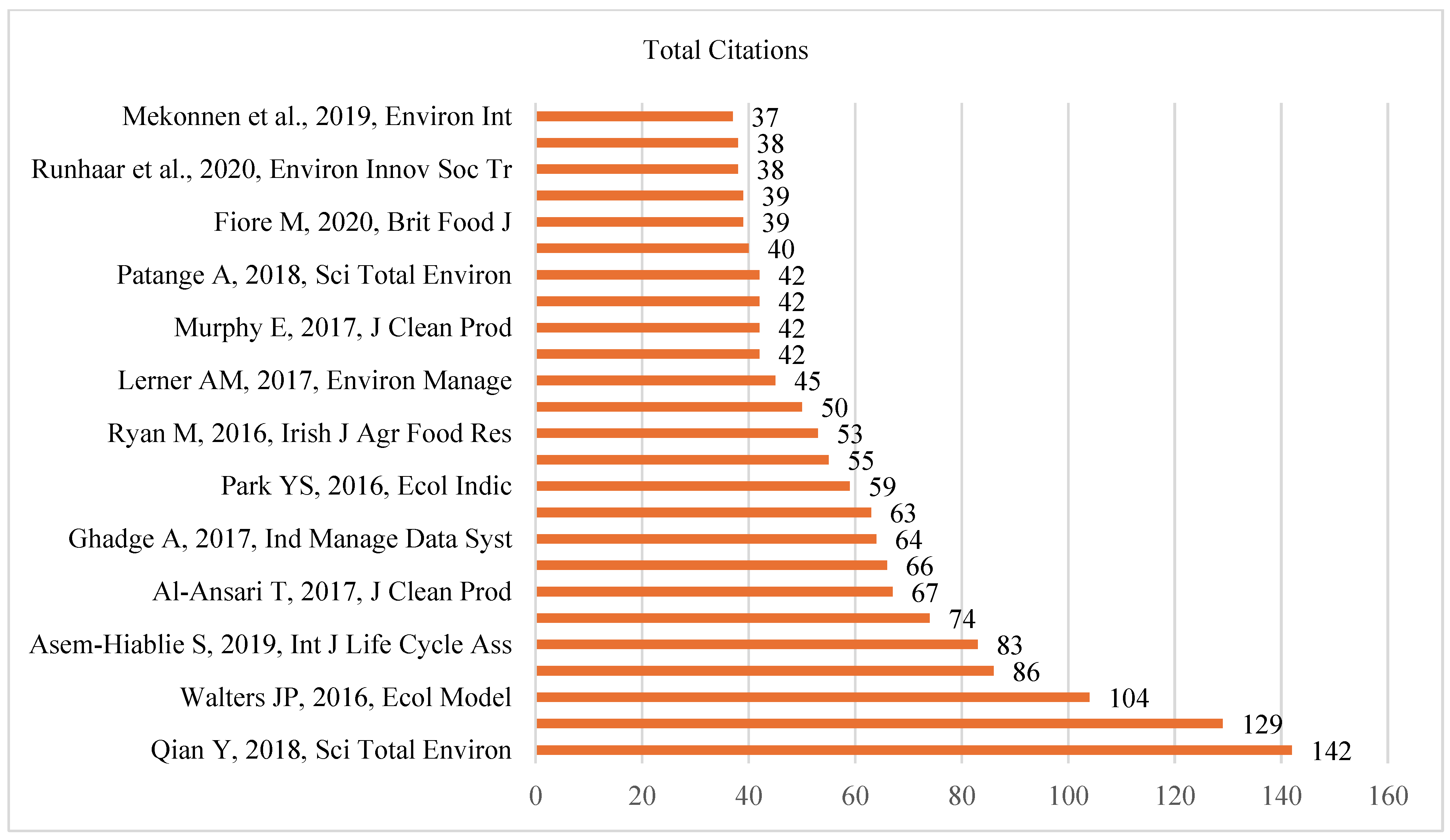From Cow to Climate—Tracing the Path of Dairy Sustainability: Unveiling the Impact on Sustainable Development Goals Through Bibliometric and Literature Analyses
Simple Summary
Abstract
1. Introduction
1.1. Sustainable Intensification
1.2. Multifunctional Agriculture
1.3. Agro-Ecology
2. Materials and Methods
3. Results
3.1. The Publication Trends
3.1.1. Annual Number of Publications from 2015 to 2023
3.1.2. Price Law
3.2. Prolific Sources, Articles, and Authors
- Most Relevant Sources
- Most Cited Journals
- The Sources’ Impact
- Most Cited articles
- Journal Listings and Article distribution Based on Bradford Law
- Prolific Scholars
- Number of Articles Published by Country Over Time
- Lotka’s Law
- Co-occurrence of Keywords
3.3. A Literature Review of the Top Twenty Most Cited Articles
3.4. Thematic Analysis
- Theme 1. Livestock Management
- Theme 2. Feed Production and Management
- Theme 3. Innovation
- Theme 4. Stakeholder Involvement
- Theme 5. Logistics and Supply Chain Management
- Theme 6. Waste Management
4. Discussion, Conclusions, and Recommendations
Author Contributions
Funding
Institutional Review Board Statement
Informed Consent Statement
Data Availability Statement
Acknowledgments
Conflicts of Interest
References
- Ravichandran, T.; Teufel, N.; Capezzone, F.; Birner, R.; Duncan, A.J. Stimulating smallholder dairy market and livestock feed improvements through local innovation platforms in the Himalayan foothills of India. Food Policy 2020, 95, 101949. [Google Scholar] [CrossRef]
- Astuti, P.K.; Ayoob, A.; Strausz, P.; Vakayil, B.; Kumar, S.H.; Kusza, S. Climate change and dairy farming sustainability; A causal loop paradox and its mitigation scenario. Heliyon 2024, 10, e25200. [Google Scholar] [PubMed]
- Ouatahar, L.; Bannink, A.; Zentek, J.; Amon, T.; Deng, J.; Hempel, S.; Janke, D.; Beukes, P.; van der Weerden, T.; Krol, D.; et al. An integral assessment of the impact of diet and manure management on whole-farm greenhouse gas and nitrogen emissions in dairy cattle production systems using process-based models. Waste Manag. 2024, 187, 79–90. [Google Scholar] [PubMed]
- Becciolini, V.; Leso, L.; Gimeno, E.F.; Rossi, G.; Barbari, M.; Marta, A.D.; Orlandini, S.; Verdi, L. Nitrogen loss abatement from dairy cow excreta through urine and faeces separation: The effect of temperature and exposure period on NH3 fluxes. Agric. Syst. 2024, 216, 103898. [Google Scholar]
- Singaravadivelan, A.; Sachin, P.B.; Harikumar, S.; Vijayakumar, P.; Vindhya, M.V.; Farhana, F.M.B.; Rameesa, K.K.; Mathew, J. Life cycle assessment of greenhouse gas emission from the dairy production system—review. Trop. Anim. Health Prod. 2023, 55, 320. [Google Scholar]
- Shabir, I.; Dash, K.K.; Dar, A.H.; Pandey, V.K.; Fayaz, U.; Srivastava, S. Carbon footprints evaluation for sustainable food processing system development: A comprehensive review. Future Foods 2023, 7, 100215. [Google Scholar]
- Peterson, C.B.; Mitloehner, F.M. Sustainability of the dairy industry: Emissions and mitigation opportunities. Front. Aminal Sci. 2021, 2, 760310. [Google Scholar]
- Bolan, S.; Padhye, L.P.; Jasemizad, T.; Govarthanan, M.; Karmegam, N.; Wijesekara, H.; Amarasiri, D.; Hou, D.; Zhou, P.; Biswal, B.K.; et al. Impacts of climate change on the fate of contaminants through extreme weather events. Sci. Total Environ. 2024, 909, 168388. [Google Scholar]
- Pope, D.H.; Karlsson, J.O.; Baker, P.; McCoy, D. Examining the environmental impacts of the dairy and baby food industries: Are first-food systems a crucial missing part of the healthy and sustainable food systems agenda now underway? Int. J. Environ. Res. Public Health 2021, 18, 12678. [Google Scholar] [CrossRef]
- Liebe, D.L.; Hall, M.B.; White, R.R. Contributions of dairy products to environmental impacts and nutritional supplies from United States agriculture. J. Dairy Sci. 2020, 103, 10867–10881. [Google Scholar]
- Godde, C.M.; Mason-D’Croz, D.; Mayberry, D.E.; Thornton, P.K.; Herrero, M. Impacts of climate change on the livestock food supply chain; A review of the evidence. Glob. Food Sec. 2021, 28, 100488. [Google Scholar] [PubMed]
- Holden, L.A. Understanding the environmental impact of global dairy production. J. Anim. Sci. 2020, 98, skz365. [Google Scholar]
- McCabe, C. How Dairy Milk Has Improved Its Environmental and Climate Impact CLEAR Center. 2021. Available online: https://clear.ucdavis.edu/explainers/how-dairy-milk-has-improved-its-environmental-and-climate-impact (accessed on 18 August 2024).
- Manisalidis, I.; Stavropoulou, E.; Stavropoulos, A.; Bezirtzoglou, E. Environmental and Health Impacts of Air Pollution: A Review. Front. Public Health 2020, 8, 505570. [Google Scholar]
- Ferreira, C.S.; Seifollahi-Aghmiuni, S.; Destouni, G.; Ghajarnia, N.; Kalantari, Z. Soil degradation in the European Mediterranean region: Processes, status and consequences. Sci. Total Environ. 2022, 805, 150106. [Google Scholar] [PubMed]
- Clay, N.; Gernett, T.; Lorimer, J. Dairy intensification: Drivers, impacts, and alternatives. Ambio 2020, 49, 35–48. [Google Scholar] [PubMed]
- Huang, X.; Shi, B.; Wang, S.; Yin, C.; Fang, L. Mitigating environmental impacts of milk production via integrated maize silage planting and dairy cow breeding system: A case study in China. J. Clean Prod. 2021, 309, 127343. [Google Scholar]
- Tricarico, J.M.; Kebreab, E.; Wattiaux, M.A. MILK Symposium review: Sustainability of dairy production and consumption in low-income countries with emphasis on productivity and environmental impact. J. Dairy Sci. 2020, 103, 9791–9802. [Google Scholar]
- Chaudhary, A.; Timsina, P.; Karki, E.; Sharma, A.; Suri, B.; Sharma, R.; Brown, B. Contextual realities and poverty traps: Why South Asian smallholder farmers negatively evaluate conservation agriculture. Renew. Agric. Food Syst. 2023, 38, e13. [Google Scholar]
- Amgain, L.P.; Devkota, K.P.; Marahatta, S.; Karki, T.B.; Kafle, S.; Dulal, P.R.; Subedi, S.; Magar, S.T.; Timsina, J. Conservation Agriculture Technologies for Cropping Systems Sustainability and Food and Nutrition Security in Nepal; Sustainable Development Goals Series; Springer: Berlin/Heidelberg, Germany, 2022; Volume 44. [Google Scholar]
- Verduna, T.; Blanc, S.; Merlino, V.M.; Cornale, P.; Battaglini, L. Sustainability of four dairy farming scenarios in an Alpine environment: The case study of Toma di Lanzo Cheese. Front. Vet. Sci. 2020, 7, 569167. [Google Scholar]
- Shamsuddoha, M.; Nasir, T.; Hossain, N.U.I. A sustainable supply chain framework for dairy farming operations: A system dynamics approach. Sustainability 2023, 15, 8417. [Google Scholar] [CrossRef]
- Renting, H.; Rossing, W.; Groot, J.; Van der Ploeg, J.; Laurent, C.; Perraud, D.; Stobbelaar, D.; Van Ittersum, M. Exploring multifunctional agriculture. A review of conceptual approaches and prospects for an integrative transitional framework. J. Environ. Manag. 2009, 90, S112–S123. [Google Scholar]
- The World Bank. Moving towards sustainability: The livestock sector and the World Bank The World Bank Organization. 2021. Available online: https://www.worldbank.org/en/topic/agriculture/brief/moving-towards-sustainability-the-livestock-sector-and-the-world-bank (accessed on 18 August 2024).
- Mockshell, J.; Villarino, M.E.J. Agroecological Intensification: Potential and Limitations to Achieving Food Security and Sustainability. Encycl. Food Secur. Sustain. 2019, 3, 64–70. [Google Scholar] [CrossRef]
- Bezner Kerr, R.; Madsen, S.; Stüber, M.; Liebert, J.; Enloe, S.; Borghino, N.; Parros, P.; Mutyambai, D.M.; Prudhon, M.; Wezel, A. Can agroecology improve food security and nutrition? A review. Glob. Food Sec. 2021, 29, 100540. [Google Scholar]
- Boz, I. Effects of environmentally friendly agricultural land protection programs: Evidence from the Lake Seyfe area of Turkey. J. Integr. Agric. 2016, 15, 1903–1914. [Google Scholar]
- Ahmad, N.; Köpke, S. Agroecological approaches to securing rural livelihoods: A critical analysis using the example of Tanzania. Front. Sustain. Food Syst. 2024, 8, 1443002. [Google Scholar]
- Tranchina, M.; Reubens, B.; Frey, M.; Mele, M.; Mantino, A. What challenges impede the adoption of agroforestry practices? A global perspective through a systematic literature review. Agrofor. Syst. 2024, 98, 1817–1837. [Google Scholar]
- Talukdar, D.; Hariharan, V.G.; Boo, C. Empirical regularity in academic research productivity patterns in marketing. Int. J. Res. Mark. 2011, 28, 248–257. [Google Scholar]
- Hirsch, J.E. An index to quantify an individual’s scientific research output. Proc. Natl. Acad. Sci. USA 2005, 102, 16569–16572. [Google Scholar] [CrossRef]
- Qian, Y.; Song, K.; Hu, T.; Ying, T. Environmental status of livestock and poultry sectors in China under current transformation stage. Sci. Total Environ. 2018, 622, 702–709. [Google Scholar]
- Walters, J.P.; Archer, D.W.; Sassenrath, G.F.; Hendrickson, J.R.; Hanson, J.D.; Halloran, J.M.; Vadas, P.; Alarcon, V.J. Exploring agricultural production systems and their fundamental components with system dynamics modelling. Ecol. Model. 2016, 333, 51–65. [Google Scholar]
- Asem-Hiablie, S.; Battagliese, T.; Stackhouse-Lawson, K.R.; Alan Rotz, C. A life cycle assessment of the environmental impacts of a beef system in the USA. Int. J. Life Cycle Assess. 2019, 24, 441–455. [Google Scholar] [CrossRef]
- Al-Ansari, T.; Korre, A.; Nie, Z.; Shah, N. Integration of greenhouse gas control technologies within the energy, water and food nexus to enhance the environmental performance of food production systems. J. Clean Prod. 2017, 162, 1592–1606. [Google Scholar] [CrossRef]
- Ghadge, A.; Kaklamanou, M.; Choudhary, S.; Bourlakis, M. Implementing environmental practices within the Greek dairy supply chain: Drivers and barriers for SMEs. Ind. Manag. Data Syst. 2017, 117, 1995–2014. [Google Scholar] [CrossRef]
- Park, Y.S.; Egilmez, G.; Kucukvar, M. Emergy and end-point impact assessment of agricultural and food production in the United States: A supply chain-linked Ecologically-based Life Cycle Assessment. Ecol. Indic. 2016, 62, 117–137. [Google Scholar] [CrossRef]
- Ryan, M.; Hennessy, T.; Buckley, C.; Dillon, E.; Donnellan, T.; Hanrahan, K.; Moran, B. Developing farm-level sustainability indicators for Ireland using the Teagasc National Farm Survey. Ir. J. Agric. Food Res. 2016, 55, 112–125. [Google Scholar] [CrossRef]
- Lerner, A.M.; Zuluaga, A.F.; Chará, J.; Etter, A.; Searchinger, T. Sustainable cattle ranching in practice: Moving from theory to planning in Colombia’s livestock sector. Environ. Manag. 2017, 60, 176–184. [Google Scholar] [CrossRef]
- Murphy, E.; de Boer, I.; van Middelaar, C.; Holden, N.; Shalloo, L.; Curran, T.; Upton, J. Water footprinting of dairy farming in Ireland. J. Clean Prod. 2017, 140, 547–555. [Google Scholar] [CrossRef]
- Patange, A.; Boehm, D.; Giltrap, M.; Lu, P.; Cullen, P.; Bourke, P. Assessment of the disinfection capacity and eco-toxicological impact of atmospheric cold plasma for treatment of food industry effluents. Sci. Total Environ. 2018, 631, 298–307. [Google Scholar] [CrossRef]
- Fiore, M.; Galati, A.; Gołębiewski, J.; Drejerska, N. Stakeholders’ involvement in establishing sustainable business models: The case of Polish dairy cooperatives. Br. Food J. 2020, 122, 1671–1691. [Google Scholar] [CrossRef]
- Mekonnen, M.M.; Neale, C.M.U.; Ray, C.; Erickson, G.E.; Hoekstra, A.Y. Water productivity in meat and milk production in the US from 1960 to 2016. Environ. Int. 2019, 132, 105084. [Google Scholar] [CrossRef]
- Runhaar, H.; Fünfschilling, L.; van den Pol-Van Dasselaar, A.; Moors EH, M.; Temmink, R.; Hekkert, M. Endogenous regime change: Lessons from transition pathways in Dutch dairy farming. Environ. Innov. Soc. Transit. 2020, 36, 137–150. [Google Scholar] [CrossRef]
- Uwizeye, A.; de Boer, I.J.M.; Opio, C.I.; Schulte, R.P.O.; Falcucci, A.; Tempio, G.; Teillard, F.; Casu, F.; Rulli, M.; Galloway, J.N.; et al. Nitrogen emissions along global livestock supply chains. Nat. Food 2020, 1, 437–446. [Google Scholar]
- Ritchie, H.; Reay, D.S.; Higgins, P. The impact of global dietary guidelines on climate change. Glob. Environ. Change 2018, 49, 46–55. [Google Scholar]
- Mangla, S.K.; Sharma, Y.K.; Patil, P.P.; Yadav, G.; Xu, J. Logistics and distribution challenges to managing operations for corporate sustainability: Study on leading Indian diary organizations. J. Clean Prod. 2019, 238, 117620. [Google Scholar]
- Richter, B.D.; Bartak, D.; Caldwell, P.; Davis, K.F.; Debaere, P.; Hoekstra, A.Y.; Li, T.; Marston, L.; McManamay, R.; Mekonnen, M.M.; et al. Water scarcity and fish imperilment driven by beef production. Nat. Sustain. 2020, 3, 319–328. [Google Scholar] [CrossRef]
- Chen, W.; Holden, N.M. Social life cycle assessment of average Irish dairy farm. Int. J. Life Cycle Assess. 2017, 22, 1459–1472. [Google Scholar] [CrossRef]
- Ghadge, A.; Er Kara, M.; Mogale, D.G.; Choudhary, S.; Dani, S. Sustainability implementation challenges in food supply chains: A case of UK artisan cheese producers. Prod. Plan. Control 2021, 32, 1191–1206. [Google Scholar]
- Vermunt, D.A.; Negro, S.O.; Van Laerhoven, F.S.J.; Verweij, P.A.; Hekkert, M.P. Sustainability transitions in the agri-food sector: How ecology affects transition dynamics. Environ. Innov. Soc. Transit. 2020, 36, 236–249. [Google Scholar]
- Hjalsted, A.W.; Laurent, A.; Andersen, M.M.; Olsen, K.H.; Ryberg, M.; Hauschild, M. Sharing the safe operating space: Exploring ethical allocation principles to operationalize the planetary boundaries and assess absolute sustainability at individual and industrial sector levels. J. Ind. Ecol. 2021, 25, 6–19. [Google Scholar]
- Cole, A.J.; De Nys, R.; Paul, N.A. Biorecovery of nutrient waste as protein in freshwater macroalgae. Algal Res. 2015, 7, 58–65. [Google Scholar]
- Makkar, H.P. Smart livestock feeding strategies for harvesting triple gain–the desired outcomes in planet, people and profit dimensions: A developing country perspective. Anim. Prod. Sci. 2016, 56, 519–534. [Google Scholar] [CrossRef]
- Tse, C.; Barkema, H.W.; DeVries, T.J.; Rushen, J.; Pajor, E.A. Impact of automatic milking systems on dairy cattle producers’ reports of milking labour management, milk production and milk quality. Animal 2018, 12, 2649–2656. [Google Scholar] [CrossRef] [PubMed]
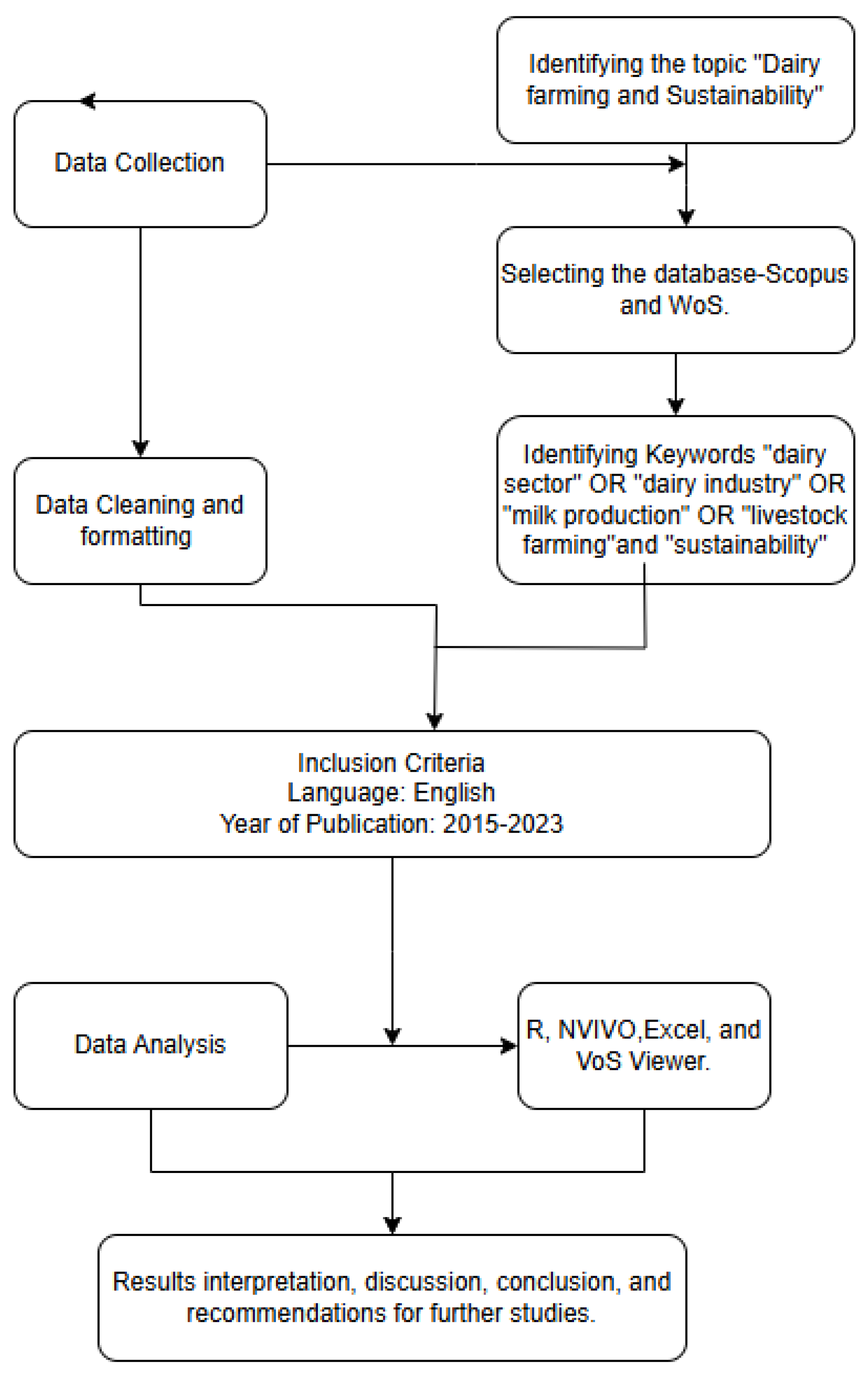
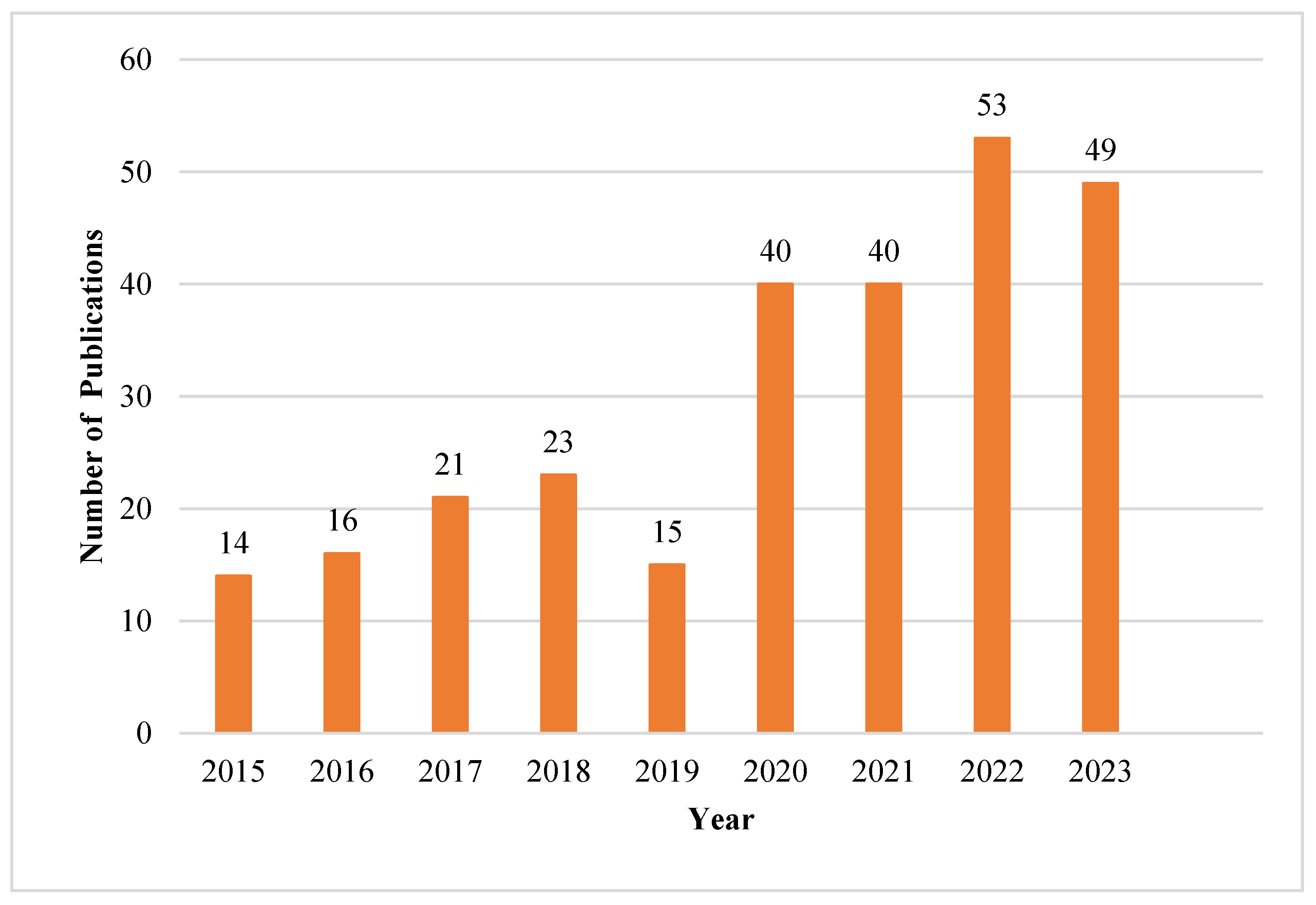
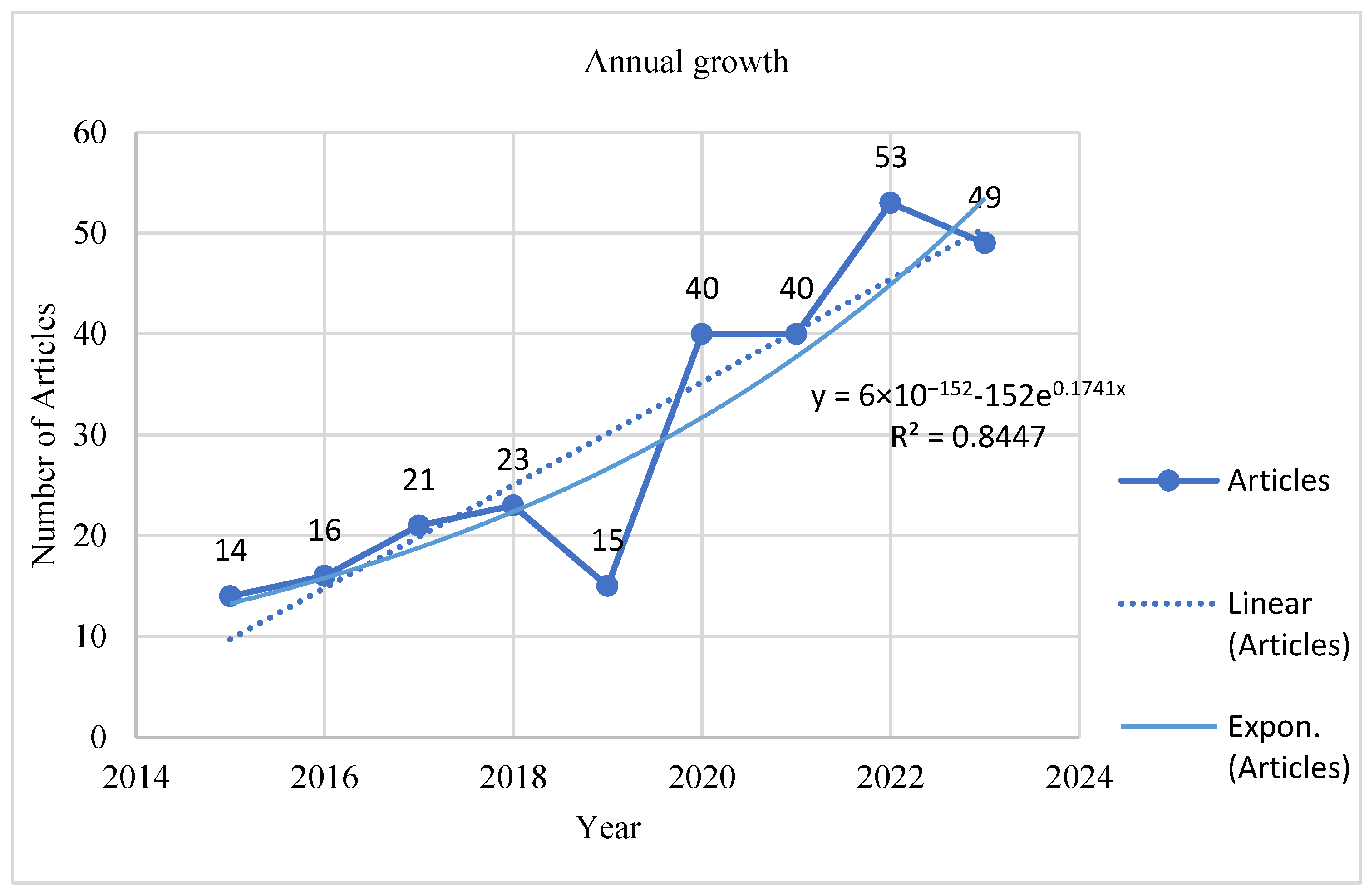
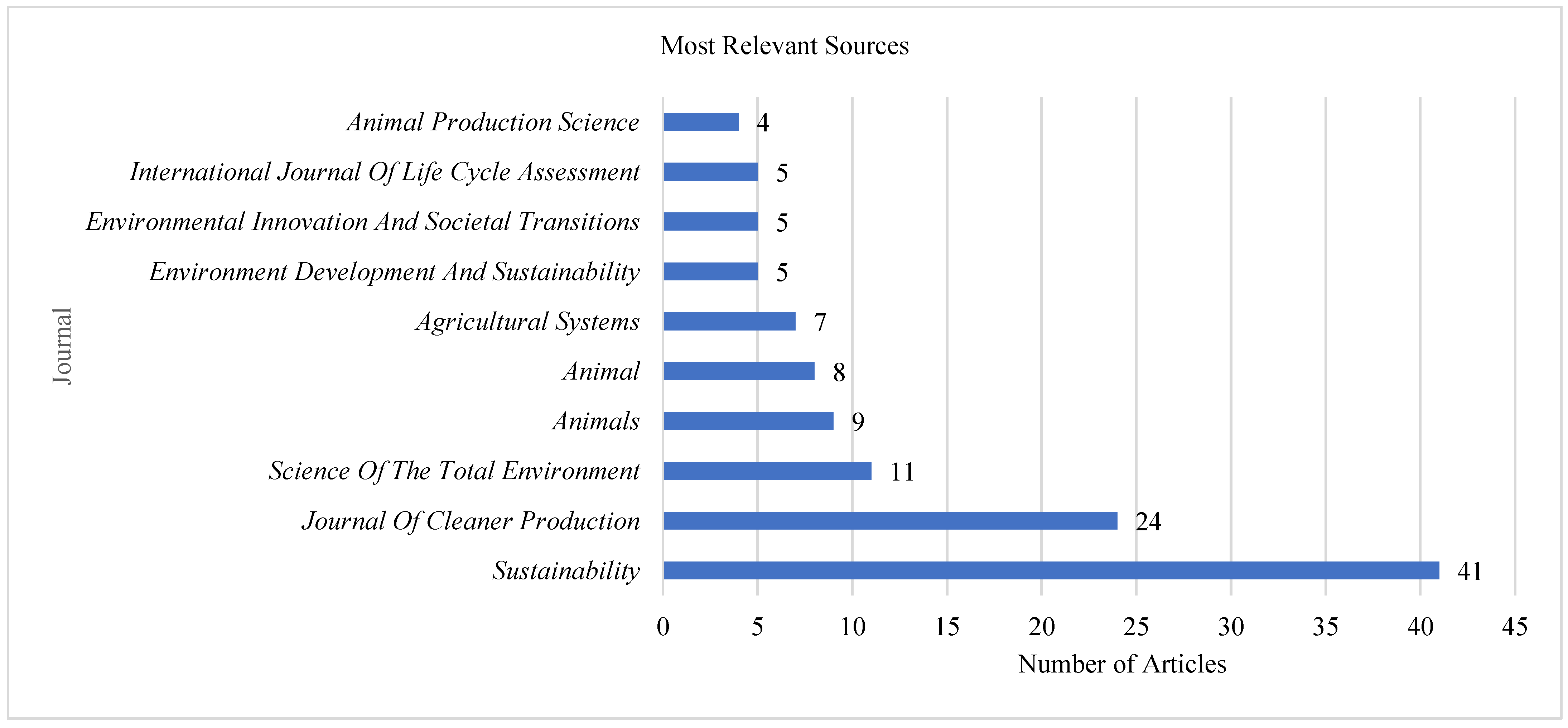

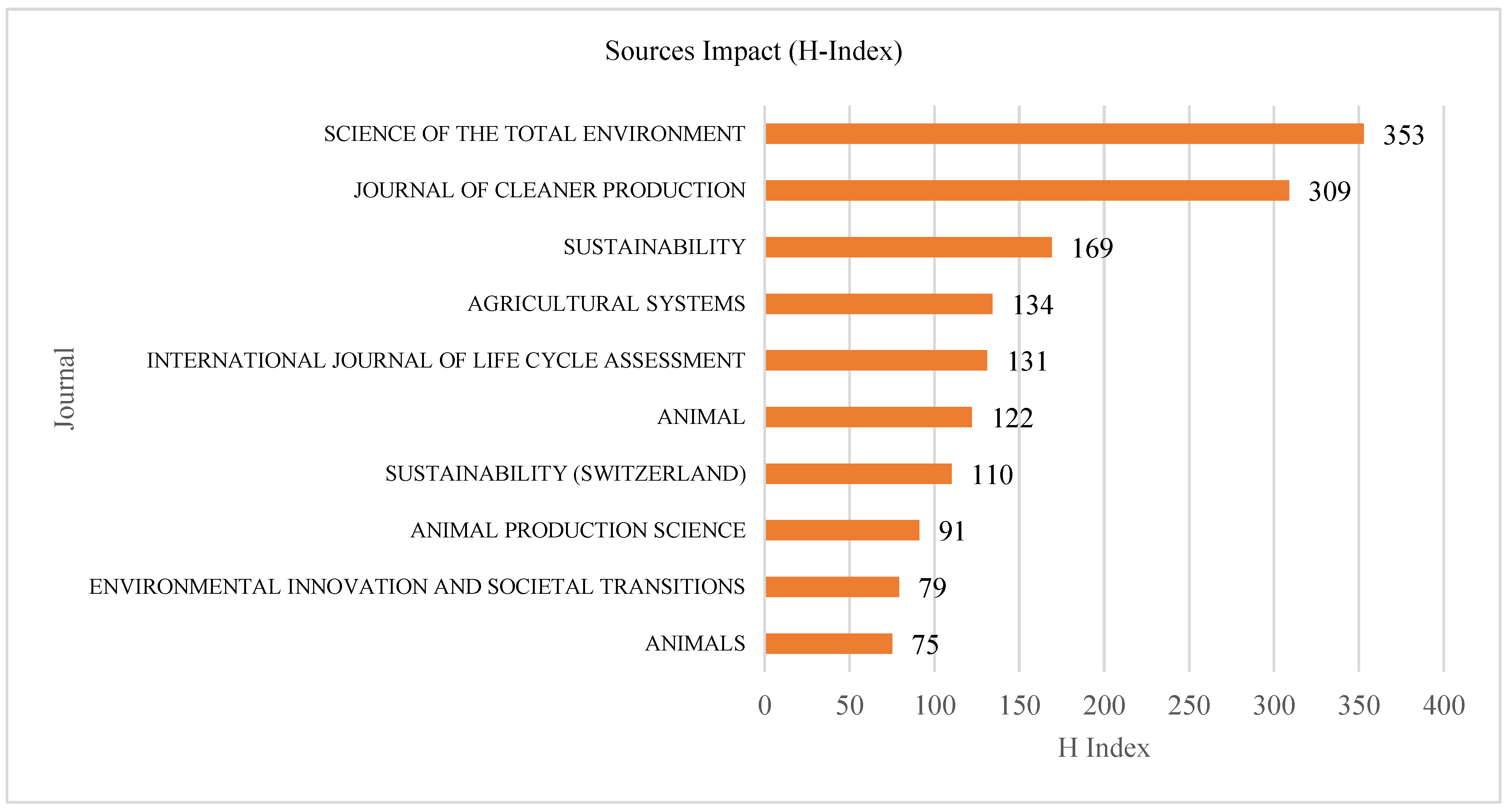
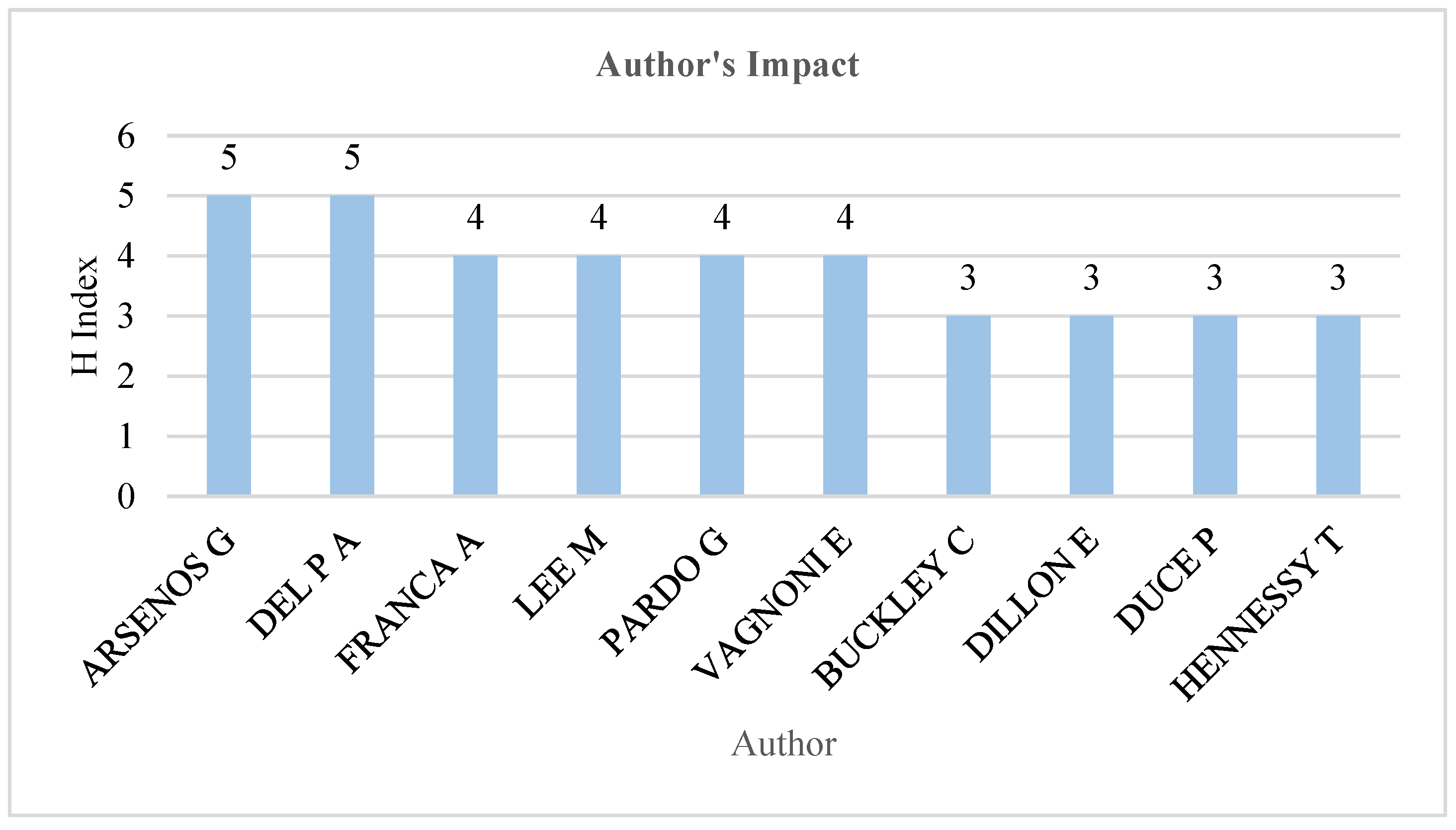
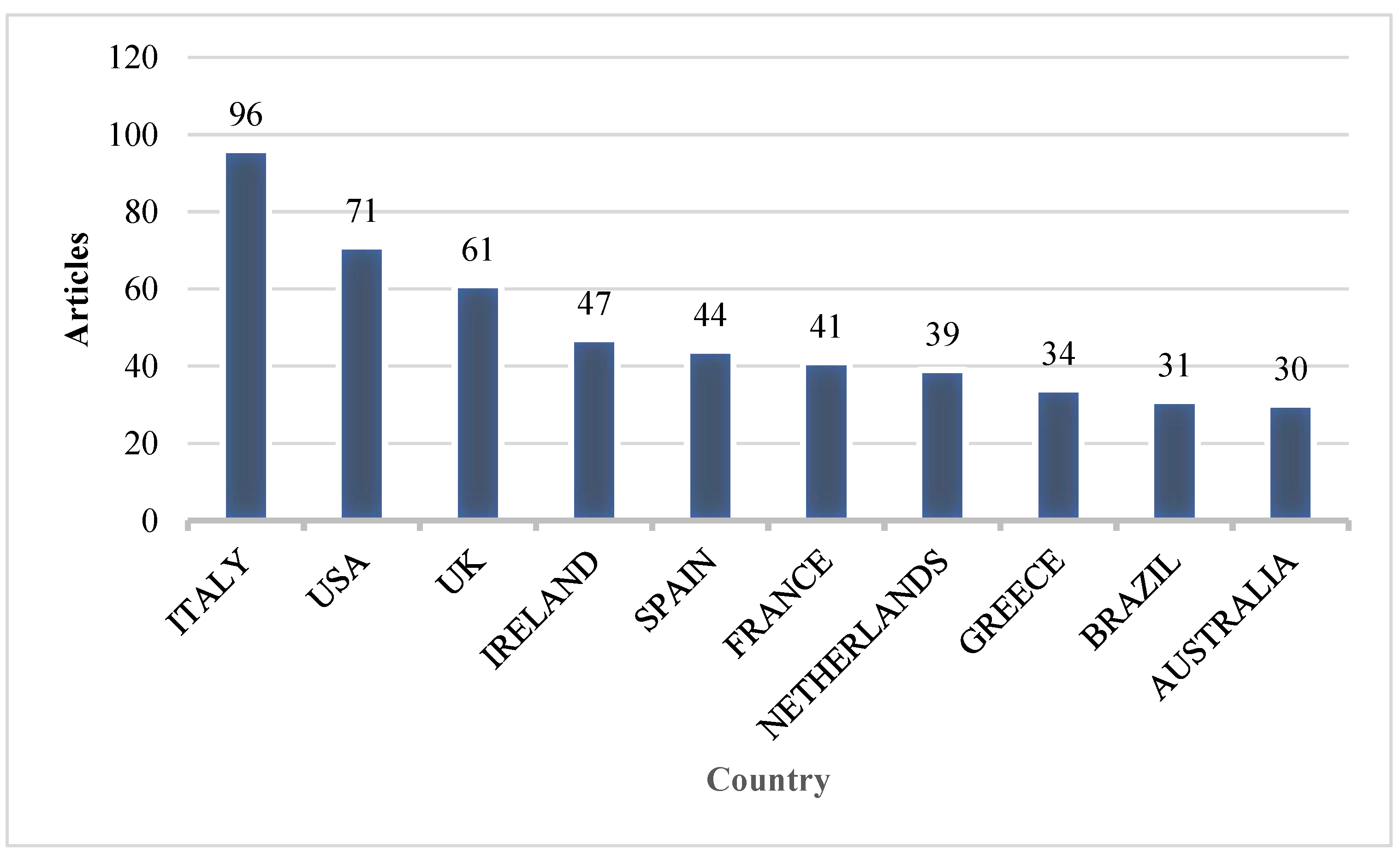
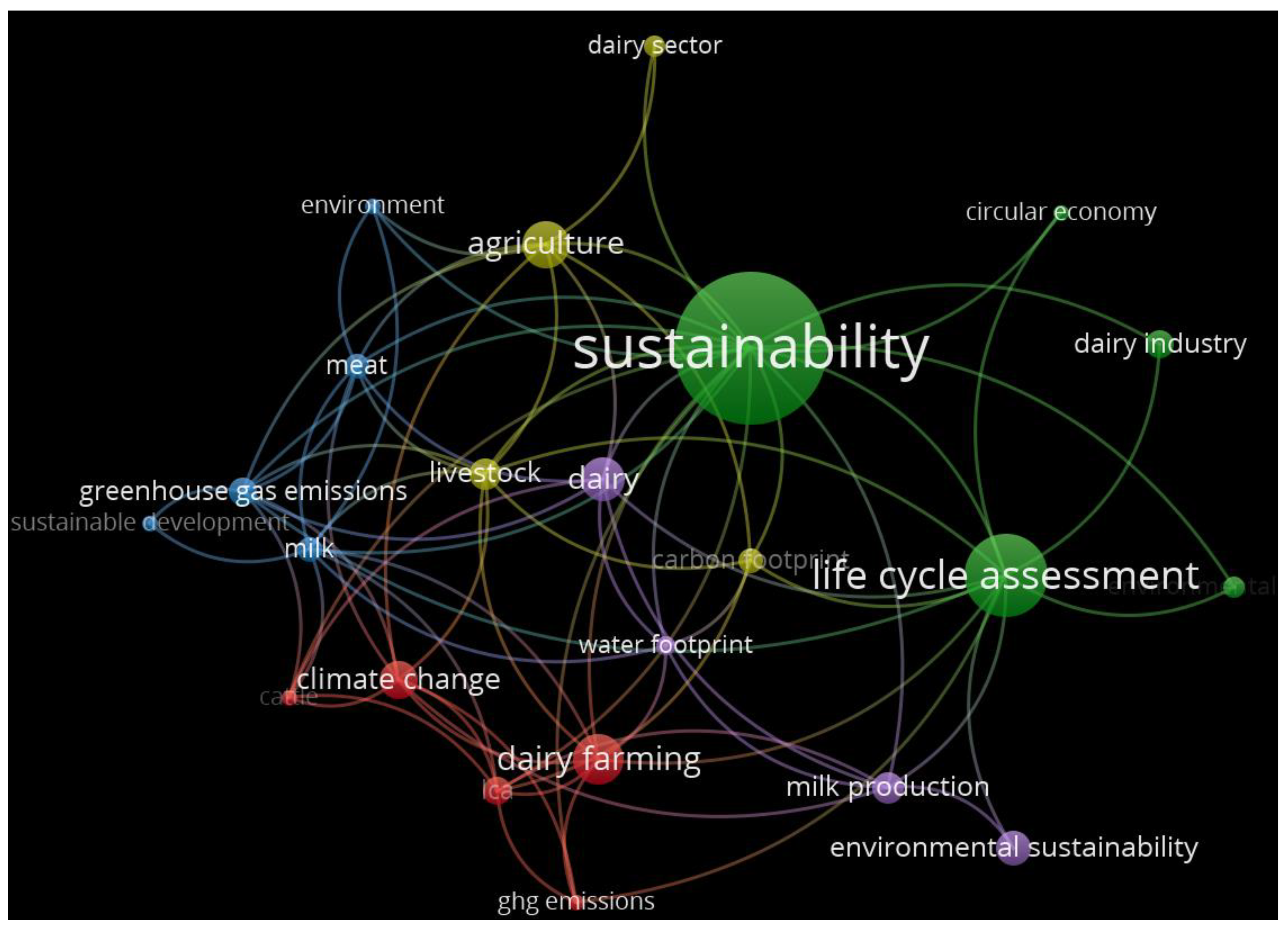
| Search Results | ||
|---|---|---|
| Terms that were searched are “dairy sector” OR “dairy industry” OR “milk production” OR “livestock farming” AND “sustainability” OR “sustainable development goals” OR “SDGs” | ||
| Scopus | WoS | |
| Article | 134 | 243 |
| Conference | 19 | 7 |
| Paper Review | 28 | 6 |
| Book Chapter | 14 | 6 |
| Book | 1 | 2 |
| Limit to document type, relevant area | ||
| Articles | 134 | 243 |
| Total | 377 | |
| Cumulative Total | 102 | |
| Duplicates | 275 | |
| Remaining | 0 | |
| Abstract Review | 275 | |
| Articles Reviewed |
| Bradford Law | |||||
|---|---|---|---|---|---|
| Journals | Articles | ||||
| N | % | N | % | ||
| Zone 1 | 5 | 4% | Zone 1 | 93 | 34% |
| Zone 2 | 33 | 26% | Zone 2 | 91 | 33% |
| Zone 3 | 90 | 70% | Zone 3 | 90 | 33% |
| 128 | 274 | ||||
| Documents Written | No. of Authors | Proportion of Authors |
|---|---|---|
| 1 | 1025 | 0.872 |
| 2 | 123 | 0.105 |
| 3 | 18 | 0.015 |
| 4 | 6 | 0.005 |
| 5 | 4 | 0.003 |
| Author(s), Year, and Journal | Title of Paper | Citations | Contribution to Dairy Sector and Sustainability |
|---|---|---|---|
| Qian et al., 2018 | Environmental status of livestock and poultry sectors in China under current transformation stage [32] | 142 | The paper provides policy recommendations for sustainable practices, including regulatory control, proper manure treatment, and financial incentives to promote ecological agriculture in China. Overall, the research underscores the need for sustainable livestock and poultry production. |
| Uwizeye et al., 2020 | Nitrogen emissions along global livestock supply chains [45] | 129 | The article suggests targeted interventions to reduce N pollution, such as improved fertilizer policies and integrated livestock feed production. Global initiatives are needed to address N emissions while ensuring food security. |
| Walters et al., 2016 | Exploring agricultural production systems and their fundamental components with system dynamics modelling [33] | 104 | The researchers evaluated three distinct production systems: crops only, livestock only, and an integrated crops and livestock system. They analyzed the role of each driver in determining sustainability differences among these systems. The greatest potential for sustainability exists in the crops-only production system. |
| Ritchie et al., 2018 | The impact of global dietary guidelines on climate change [46] | 86 | Dairy intake is responsible for variations in emissions. Effective decarbonization requires not only a shift in dietary preferences but also a reevaluation of the recommendations supporting this transition. Improvements in feed production and use present significant opportunities for reducing environmental impacts. |
| Asem-Hiablie et al., 2019 | A life cycle assessment of the environmental impacts of a beef and dairy system in the USA [34] | 83 | The study examines the environmental impact of livestock keeping. According to the research, identifying areas for improvement in feed production and use, such as increasing crop and pasture yields, could be key to reducing environmental impacts. The cattle production phase (feed and cow–calf phase), including feed production, cow–calf, and finishing, has the most influence on most environmental categories. |
| Mangla et al., 2019 | Logistics and distribution challenges to managing operations for corporate sustainability: Study on leading Indian diary organizations [47] | 74 | The research highlights the environmental impact of the dairy industry, including high greenhouse gas emissions and food wastage. It suggests that addressing cold chain management is crucial for reducing wastage, financial losses, and environmental issues. |
| Al-Ansari et al., 2017 | Integration of greenhouse gas control technologies within the energy, water, and food nexus to enhance the environmental performance of food production systems [35] | 67 | The paper introduces a system that recycles solid waste from the dairy sector into useful energy, specifically mentioning dairy manure as a feedstock for the gasification process. Carbon capture technology is integrated with BIGCC, transforming it into a negative greenhouse gas emission technology, which could result in a near carbon-neutral food system. |
| Richter et al., 2020. | Water scarcity and fish imperilment driven by beef production [48] | 66 | The research explores water scarcity and fish imperilment in cattle farming. According to the findings, irrigation of cattle feed crops is useful, and beef and dairy consumption is the largest consumer of river water in the Western United States, significantly impacting water scarcity and causing ecological imbalance. The study suggests that reducing cattle feed crops and rotational fallowing can enhance ecological sustainability. |
| Ghadge et al., 2017. | Implementing environmental practices within the Greek dairy supply chain: Drivers and barriers for SMEs [36] | 64 | The study established that internal as well as external drivers influence the implementation of sustainable practices in the FSC. However, internal drivers carry higher weightage in the drive towards sustainability. |
| Chen et al., 2017. | Social life cycle assessment of average Irish dairy farm [49] | 63 | The study noted that Irish dairy farming has positive social impacts on value chain actors and society, with predominantly positive impacts on the local community and generally positive impacts on workers. Improving manure storage, introducing better handling methods, and using real-time decision support for operational management, as well as robots, have the potential to reduce emissions that cause adverse “health and safe living condition” impacts on the local community. |
| Park et al., 2016 | Energy and end-point impact assessment of agricultural and food production in the United States: A supply chain-linked Ecologically based Life Cycle Assessment [37] | 59 | Grain farming, dairy food, and animal production-related sectors were found to have the greatest shares in both environmental and ecological impact categories as well as endpoint impact. Integrating biological and ecological concepts into agri-food production will minimize the use of nonrenewable resources. Reducing food waste, improving the efficiency of operations and processes, using proper solar energy in the agri-food sector, and converting intensive agriculture into organic farming can enhance sustainability. |
| Ghadge et al., 2021. | Sustainability implementation challenges in food supply chains: a case of UK artisan cheese producers [50] | 55 | The analysis identified several key barriers, including the initial investment cost, firm size, and unawareness of government regulations. Internal barriers significantly dominate the implementation of sustainability practices in comparison to external barriers. A lack of consensus regarding the concept of sustainability by different stakeholders is observed to be an issue negatively affecting the level of integration in SMEs. |
| Ryan et al., 2016. | Developing farm-level sustainability indicators for Ireland using the Teagasc National Farm Survey [38] | 53 | The analysis undertaken in this study showed that dairy farms, followed by tillage farms, tend to be the most economically sustainable of the four farm systems examined. Intensive dairy systems produce more GHGs than other less-intensive systems, and the consistent pattern across all farm systems is the positive correlation between economic performance and environmental sustainability, driven by higher output and more efficient use of inputs. Increases in efficiency and productivity generate increased profits without increasing negative environmental consequences. |
| Lerner et al., 2017 | Sustainable Cattle Ranching in Practice: Moving from Theory to Planning in Colombia’s Livestock Sector [39] | 45 | The article reviews the concepts and discussions associated with reconciling cattle production and conservation. It includes disaggregating the cattle sector regionally and by production type, defining the most important areas for conservation, and understanding geographical biophysical limitations and opportunities for production strategies. It also requires coordinating across government sectors, including environmental sectors, agricultural sectors, and education= and capacity-building sectors. TEfforts to encourage more sustainable cattle production strategies can be linked to international financial mechanisms and to national goals for restoration and carbon mitigation. |
| Vermunt et al., 2020. | Sustainability transitions in the agri-food sector: How ecology affects transition dynamics [51] | 42 | Agency-incentivizing change among farmers can enhance biodiversity-friendly practices. Novelty institutional change consists of new socio-institutional frameworks and incentives for farmers to change agricultural practices, often in the form of business models. Models for change cannot easily be scaled, replicated, or standardized. |
| Murphy et al., 2017 | Water foot printing of dairy farming in Ireland [40] | 42 | The objective of this study was to determine the primary contributors to freshwater consumption in Irish dairy farms. The utilization of green water available at a low opportunity cost compared to blue water to produce milk demonstrates the sustainability of milk production in Ireland with respect to water consumption. |
| Hjalsted et al., 2021. | Sharing the safe operating space: Exploring ethical allocation principles to operationalize the planetary boundaries and assess absolute sustainability at individual and industrial sector levels [52] | 42 | The study provides a demonstration of the feasibility of the method by implementing the framework into two of the planetary boundaries (climate change and biogeochemical flows) for the dairy sectors in India, Denmark, and around the globe. A two-step process is proposed, first downscaling to the individual level using ethically founded allocation principles and then upscaling to any higher level than the individual (such as product, industry sector, or nation) through separate upscaling methods. This allows stakeholders to transparently assess their absolute sustainability status. |
| Patange et al., 2018 | Assessment of the disinfection capacity and eco-toxicological impact of atmospheric cold plasma for treatment of food industry effluents [41] | 42 | This study also investigated the eco-toxicological impact of cold plasma treatment of the effluents using a range of aquatic bioassays. Continuous ACP treatment was applied to synthetic dairy and meat effluents. The study showed the proof of principle on the safe treatment of food sector wastewater effluents using ACP for decontamination, with useful efficacy within short periods of both treatment and retention times. ACP treatment was shown as a promising technology for the reduction and complete inactivation of key indicator microorganisms in model dairy and meat wastewater effluent. |
| Cole et al., 2015. | Bio recovery of nutrient waste as protein in freshwater macroalgae [53] | 40 | The aims of this study were to investigate the relationship between nitrogen supply, biomass productivity, and the quantity and quality of protein in the freshwater macroalga, Oedogonium. Integrating the production of Oedogonium into the waste management of intensive animal production will provide a mechanism to recover nutrients which, firstly, delivers a novel source of protein for the agricultural sector and, secondly, contributes to the environmental sustainability of intensive animal production through bioremediation. |
| Fiore et al., 2020 | Stakeholders’ involvement in establishing sustainable business models: The case of Polish dairy cooperatives [42] | 39 | The aim of the study was to define a sustainable business model of dairy cooperatives and explore how stakeholders can contribute to innovation processes generated in this ecosystem. The findings of this paper show how the involvement of various stakeholders through cooperatives contributes to the development of innovations that meet customer expectations, thereby contributing to the creation of social, environmental, and economic values. The opportunity to adopt an SBM is the result of continuous interaction with various stakeholders who contribute in varying degrees to the sustainability of processes and value co-creation. |
| Makkar, 2016 | Smart livestock feeding strategies for harvesting triple gain–the desired outcomes in planet, people, and profit dimensions: a developing country perspective [54] | 39 | The analysis and synthesis presented revealed that the efficient utilization of feed resources and application of appropriate feeding strategies are vital for the sustainability of the livestock sector. The author identified and explored a series of promising innovations and practices in feed production and feeding, including balanced and phased feeding; increases in the quality and level of use of forages in diets; reductions in the use of grains; harvesting forages when nutrient availability per unit of land is at the maximum level; targeted mineral feeding; reductions in feed losses; the use of straw-based densified feed blocks; better recycling of human food wastes and human-inedible food components to feed; new business models for the production and use of urea-ammoniated straws, urea–molasses blocks, forages, and silages in smallholder farms; and the use of underutilized locally available feed crops linked with the strengthening of seed development and distribution of infrastructure. |
Disclaimer/Publisher’s Note: The statements, opinions and data contained in all publications are solely those of the individual author(s) and contributor(s) and not of MDPI and/or the editor(s). MDPI and/or the editor(s) disclaim responsibility for any injury to people or property resulting from any ideas, methods, instructions or products referred to in the content. |
© 2025 by the authors. Licensee MDPI, Basel, Switzerland. This article is an open access article distributed under the terms and conditions of the Creative Commons Attribution (CC BY) license (https://creativecommons.org/licenses/by/4.0/).
Share and Cite
Mwirigi, D.; Fekete-Farkas, M.; Borbély, C. From Cow to Climate—Tracing the Path of Dairy Sustainability: Unveiling the Impact on Sustainable Development Goals Through Bibliometric and Literature Analyses. Animals 2025, 15, 931. https://doi.org/10.3390/ani15070931
Mwirigi D, Fekete-Farkas M, Borbély C. From Cow to Climate—Tracing the Path of Dairy Sustainability: Unveiling the Impact on Sustainable Development Goals Through Bibliometric and Literature Analyses. Animals. 2025; 15(7):931. https://doi.org/10.3390/ani15070931
Chicago/Turabian StyleMwirigi, Douglas, Mária Fekete-Farkas, and Csaba Borbély. 2025. "From Cow to Climate—Tracing the Path of Dairy Sustainability: Unveiling the Impact on Sustainable Development Goals Through Bibliometric and Literature Analyses" Animals 15, no. 7: 931. https://doi.org/10.3390/ani15070931
APA StyleMwirigi, D., Fekete-Farkas, M., & Borbély, C. (2025). From Cow to Climate—Tracing the Path of Dairy Sustainability: Unveiling the Impact on Sustainable Development Goals Through Bibliometric and Literature Analyses. Animals, 15(7), 931. https://doi.org/10.3390/ani15070931





